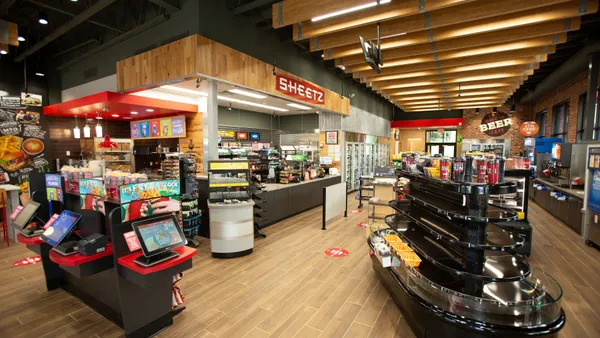Inside sales at c-stores are likely to remain pressured this year as customers remain skittish, but it’s not doom and gloom across the whole store. Bright spots include energy drinks, some segments of snacks and candy, flavored malt beverages and foodservice.
Total c-store food and beverage sales grew 1% during the first quarter of 2024, less than the 2.5% growth at multi-outlets — which includes grocery stores, e-commerce, mass market and all retail — according to David Portalatin, senior vice president and food industry advisor at Circana.
“It’s about the macro pressures consumers are under,” Portalatin said. While there has been a “little relief” in gas prices, Americans’ credit card debt has surpassed $1 trillion, Portalatin noted.
While c-stores have experienced “some softness” in food and beverage sales this year, according to Sally Lyons Wyatt, global executive vice president and chief advisor of consumer goods and foodservice insights for Circana, the numbers are relative. The 2024 sales and unit data pale in comparison to a “really big first half” of 2023, when there was an uptick in mobility due to more Americans heading back into the office.
And even though some c-stores present a better dining value than many quick service restaurants, c-store foodservice traffic dropped 5% in the first quarter, according to Circana.
“The foodservice piece of the convenience store business has been under pressure,” Portalatin noted.
Comparatively, overall restaurant visits are down 2.5% for the year ending May 19, Portalatin noted. However, over the long term, foodservice will be a growth area that c-stores will lean into.
“Food forward c-store operators generally do a little bit better,” Portalatin said.
Additionally, Technomic found that the number of consumers using c-store foodservice once or more a week rose 2 percentage points, to 59%, in the first quarter of this year, per Restaurant Business.

Energy drinks are a triple threat
While sales of some beverages in c-stores have slowed, energy drinks are performing very well and are likely to maintain significant growth for the remainder of the year, experts say.
C-store sales of energy drinks surged 10.8% on unit sales growth of 7.5% for the year ending May 19, according to Circana.
Consumers are more interested in hydration and energy benefits in all their beverages, said Portalatin, noting that sales of portable beverage containers such as Stanley cups have soared. “Hydration, energy and treat/reward — energy drinks fit the three trends consumers are leaning into,” Portalatin said.
Because many consumers “need a little boost to help them get through the day,” Lyons Wyatt said for an earlier story, energy drink sales should stay strong, and if manufactures keep the innovation coming, she predicts continued sales growth — especially in c-stores.
Room for growth in snacks and candy
Salty snacks have performed better at c-stores than other types of retailers, according to Portalatin, with overall sales growing 2.3% — although units fell 3% for the year ending May 19.
Some sub-categories of snacks are performing better than others due to innovation in flavors and variety, according to Lyons Wyatt. While tortilla chip, pork rind and premade popcorn sales declined for the year, most similar types of salty snacks saw increases.
Popcorn saw the biggest year-over-year losses among salty snacks
Sales in the snack bar/granola bars/clusters sub-category also rose almost 2%, while sales of carob or yogurt coated snacks shot up by double digits, because consumers consider them to be “permissible indulgences,” Lyons Wyatt said.
While chocolate sales continued to decline in c-stores, non-chocolate candy sales rose 2.6%.
“Novelty candy drives a lot of younger consumers and engagement…it is delivering on fun [and] it has been growing in all other channels,” Lyons Wyatt said.
The sub-segments of chocolate currently seeing growth include snack sizes and sugar-free chocolate, because they are more affordable or healthier options, Lyons Wyatt said.
Gum will likely continue to be a bright spot for c-stores, as overall sales for this year have grown by 6%, led by sugarless gum, which surged 6.9%.

Wine and spirits sales fall, but flavored beverages and beer look better
Consumer spending has slowed significantly this year — not just on beverages, but on everything from cars to sportswear and even alcohol, said Bourcard Nesin, beverage analyst for Rabobank Food and Agribusiness Research. “At this point, most operators in the [alcoholic beverage] industry would be happy with low-single digit declines for the rest of 2024,” he noted.
Overall retail sales of wine plummeted 10.9% for the first quarter of 2024, according to Wine & Spirits Wholesalers of America’s SipSource report, while sales of spirits fell 5.2%.
However, there are some bright spots for the remainder of the year, as beer sales will likely continue to perform better than wine and spirits, according to Nesin. Beer sales in all outlets increased 1.5% during a two-week period ending June 15, compared to a decline of 0.4% over the most recent quarter, according to Nielsen IQ data included in Goldman Sachs’ Americas Beverage report.
Plus, flavored malt beverage sales continue to grow, rising 5.3% in all outlets for the two weeks ending June 15, according to Goldman Sachs. Hard tea products continued their incredible growth, ballooning 20.8% for the quarter. Twisted Tea products in specific surged 12.2% during the same span.
Additionally, around one-third of the top 25 wine brands are growing, despite a down market, according to Nesin. He noted that c-stores that can carry wine should look for brands that “consistently show their ability to drive consumer demand and attract a diverse audience through consumer-facing marketing and partnerships.”
C-stores could grow alcoholic beverage sales by adding licenses for wine/spirits and “just as importantly, optimizing their assortment for evolving consumer demands,” Nesin advised. "Though it may be counterintuitive given the environment, this may mean bringing in more premium brands in wine and spirits, which not only offer better margins, but also may attract a high-spending consumer and lead to more incremental spend, as opposed to cannibalization.”
Cautious outlook for second half of 2024
There is reason to be cautious across all retail in the second half, but c-stores face additional hurdles compared to grocery stores, according to Lyons Wyatt.
"What helps c-stores is mobility and gas prices, so if consumers stay mobile and if labor stays strong … that’s a benefit,” she said. If gas prices decline, that is another tailwind helping boost industry sales.
On the other hand, the major headwinds for c-stores are the overall economic picture, including higher rents and mortgages and fluctuating labor. Consumers are “looking at the products they want at the prices they can afford” and are being more choosy about where they spend their dollars, Lyons Wyatt said. “If the headwinds could become more prominent, it could become tougher.”
For the remainder of the year, the macro headwinds that have prevailed over the first half the year are likely to continue, Portalatin said.
However, both Lyons Wyatt and Portalatin believe c-store operators can boost foodservice sales, while Lyons Wyatt encouraged the industry to offer competitive prices on all in-store food and beverage items.



















